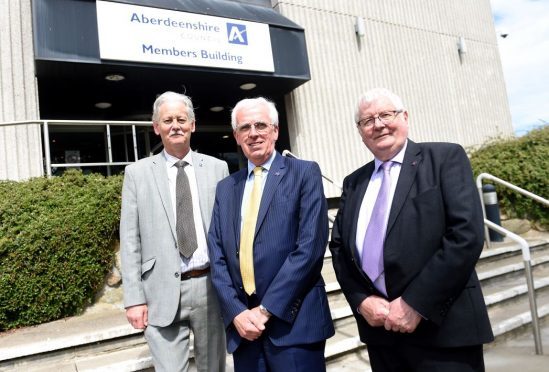Former Conservative council leader Jim Gifford has returned to power in Aberdeenshire, two years after he dramatically ousted from the position.
A Conservative, Liberal Democrat and independent coalition took charge in the chamber at Woodhill House yesterday with councillor Gifford at the helm.
The new administration is a rerun of the Alliance group which governed the region until an SNP-led coup two years ago.
The 43-member group now dominates the chamber and has taken the chairman and chairwoman posts for all the major committees.
But last night the SNP warned council majorities appear safer on paper and said they were waiting in the wings to seize back control if the leaders do not deliver for Aberdeenshire.
Yesterday’s meeting – the first official gathering since the election a fortnight ago – began with the election of a provost.
In the first public confirmation a deal had been struck, Liberal Democrat member Bill Howatson was elected as the north-east civic head, defeating independent councillor Paul Johnston by 39 votes to 25.
Councillor Howatson is now serving his second stint as provost and is joined by Conservative member Ron McKail who is his deputy.
Mr Gifford triumphed in the leadership race against SNP chief Richard Thomson – the outgoing co-leader of the authority – by 38 votes to 25.
Liberal Democrat leader, councillor Peter Argyle, was appointed as his deputy. He was unopposed for the role.
A raft of senior committee posts were then handed out to councillors from both parties and in the most surprising decision of the morning, former SNP leadership contender John Cox – now an independent – was named vice-chairman of the infrastructure committee.
The appointment of Aberdeenshire Council’s administration came only hours after a similar meeting for Aberdeen City ended in chaotic scenes as the Scottish Labour Party suspended a group of its own councillors who joined a Conservative coalition.
In contrast the discussions at Woodhill House remained cordial and the new administration said they had the blessing of the national parties.
Mr Gifford said: “It’s great to be able to put out in public what we’ve been discussing in public over the last week or so. We’ve got a good strong administration, we started on the basis it could work because it has before.”
Mr Gifford was the council leader until the summer of 2015 when his Alliance administration was overthrown by the SNP when his deputy leader Martin Kitts-Hayes switched allegiances.
“Having a reasonable majority just makes life easier,” Mr Gifford said.
“We’ve agreed to start with a clean sheet of paper and put together a group of people who can deliver for Aberdeenshire. What happened previously can be put into the annals of history and we can start afresh.”
Mr Argyle said there was little need for compromise because the two parties’ local manifestos “fitted extremely well”.
“We did speak to the SNP group but at the end of the day we decided the best option for Aberdeenshire was to come to the arrangement we have now,” he said. “Putting Aberdeenshire first is our priority. National politics are parked.”
And Norman Smith, convener of the six aligned independents who have joined the administration, added: “On the whole we’ve come to the conclusion that the things we need are best for Aberdeenshire and I think we have the numbers now to get these things done.”
HOLDING THEM TO ACCOUNT
SNP group leader Richard Thomson, who was toppled as council chief yesterday, remains bullish that his party will hold the new administration to account.
Last night Mr Thomson said he was “disappointed” but unsurprised by the outcome of the meeting.
The outgoing council co-leader revealed that, although his party had taken part in talks with the Liberal Democrats, Mr Argyle’s group was more “comfortable” with their Tory allies.
He said: “I’m disappointed we’re out of office in Aberdeenshire, but it’s been clear that is the way the negotiations have been going and the Liberal Democrats are very comfortable with the Conservatives.
“The events of today were absolutely no surprise, I am just pleased we were able to get through the business in an orderly fashion.”
Mr Thomson added that an SNP-Lib Dem alliance had been a very real prospect and that his successor will have to work hard to help the people of Aberdeenshire and defend his majority.
He said: “Our door remains open and we stand ready to form an administration.”
Mr Thomson rose to power in 2015 when his SNP group was joined by Mr Gifford’s former deputy, councillor Martin Kitts-Hayes.
They, along with two Labour members, held a slim majority for 18 months as the Partnership group.
However, Mr Kitts-Hayes resigned in disgrace last summer, after the so-called Legogate scandal, slashing the group’s majority.
